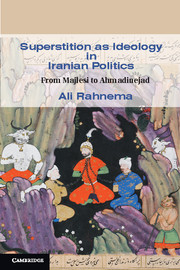Book contents
- Frontmatter
- Contents
- Preface and Acknowledgements
- Introduction
- Part I POLITICIZING OCCULT ISLAM
- Part II POPULAR SHIʿISM
- 4 Milieu, Childhood, Sanctity and Fame
- 5 From Conceptualization to Officialization of a Religio-political Ideology
- 6 Deficiency and Defectiveness of the Human Mind
- 7 Society Needs the Leadership of Jurists and/or Kings
- 8 Superstitious Education
- 9 Reconfigurating the Necessities of Belief
- 10 Majlesism as an Ideology
- Conclusion
- Bibliography
- Index
- List of Books in the Series
4 - Milieu, Childhood, Sanctity and Fame
Published online by Cambridge University Press: 05 June 2012
- Frontmatter
- Contents
- Preface and Acknowledgements
- Introduction
- Part I POLITICIZING OCCULT ISLAM
- Part II POPULAR SHIʿISM
- 4 Milieu, Childhood, Sanctity and Fame
- 5 From Conceptualization to Officialization of a Religio-political Ideology
- 6 Deficiency and Defectiveness of the Human Mind
- 7 Society Needs the Leadership of Jurists and/or Kings
- 8 Superstitious Education
- 9 Reconfigurating the Necessities of Belief
- 10 Majlesism as an Ideology
- Conclusion
- Bibliography
- Index
- List of Books in the Series
Summary
Mohammad-Baqer Majlesi was born in 1037/1627, about two years before the death of Shah ‘Abbas I and four years after Mohammad-Amin Astarabadi passed away. Each of these highly influential personalities in their respective domains impacted Mohammad-Baqer. Mohammad-Amin Astarabadi, the founder of the hadith-based Akhbari School, privileged Shiʿi reports and discarded the use and application of reason in religious arguments and deductions. His static school of thought that had a long-lasting influence on most clerics of Mohammad-Baqer's generation was highly averse to providing Shiʿi jurists with any latitude to provide a different and fresh reading and analysis of the basic Shiʿi texts.
Shah ‘Abbas's military successes, diplomatic acumen and administrative know-how had united the country and raised Iran to the status of a powerful and respectable regional and international power. Yet Shah ‘Abbas's religious behaviour was somewhat different from his predecessors. He shared with them the commitment to the propagation and support of the Shiʿi faith and humbly referred to himself as the “dog of ʿAli”. Yet he was also known for his hospitality and tolerance towards the religious minorities in Iran. The Shah considered himself the father and protector of the Christian Armenians and attended their religious festivities. He was committed to ensuring the well-being, as well as the religious rights, of minorities, including the Jews, and acted as a shield against those clerics who were anxious about the scope and activities of the non-Shiʿi in Iran.
- Type
- Chapter
- Information
- Superstition as Ideology in Iranian PoliticsFrom Majlesi to Ahmadinejad, pp. 159 - 183Publisher: Cambridge University PressPrint publication year: 2011



